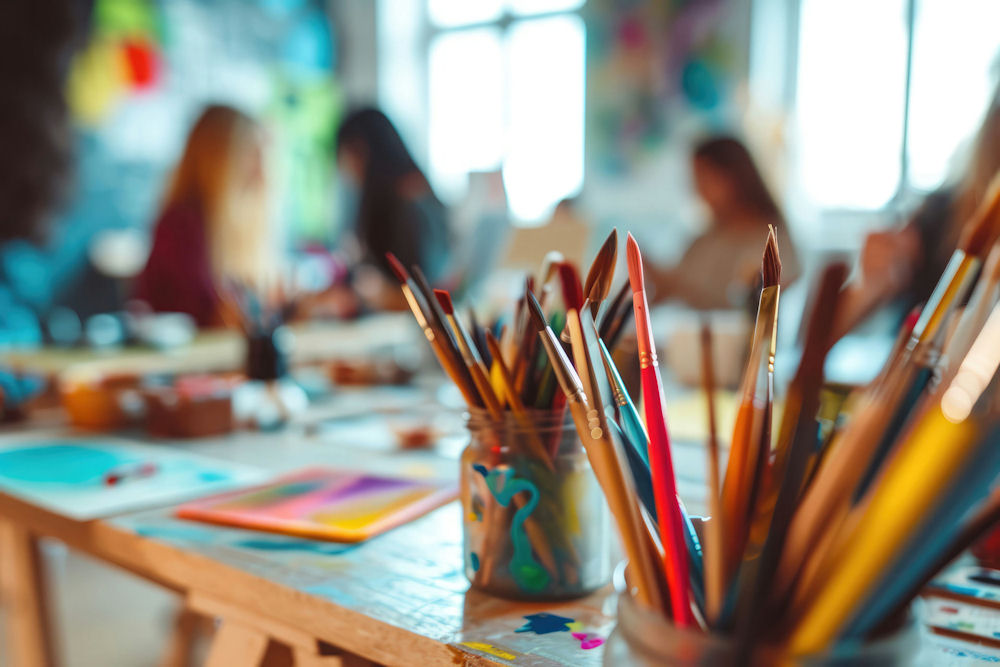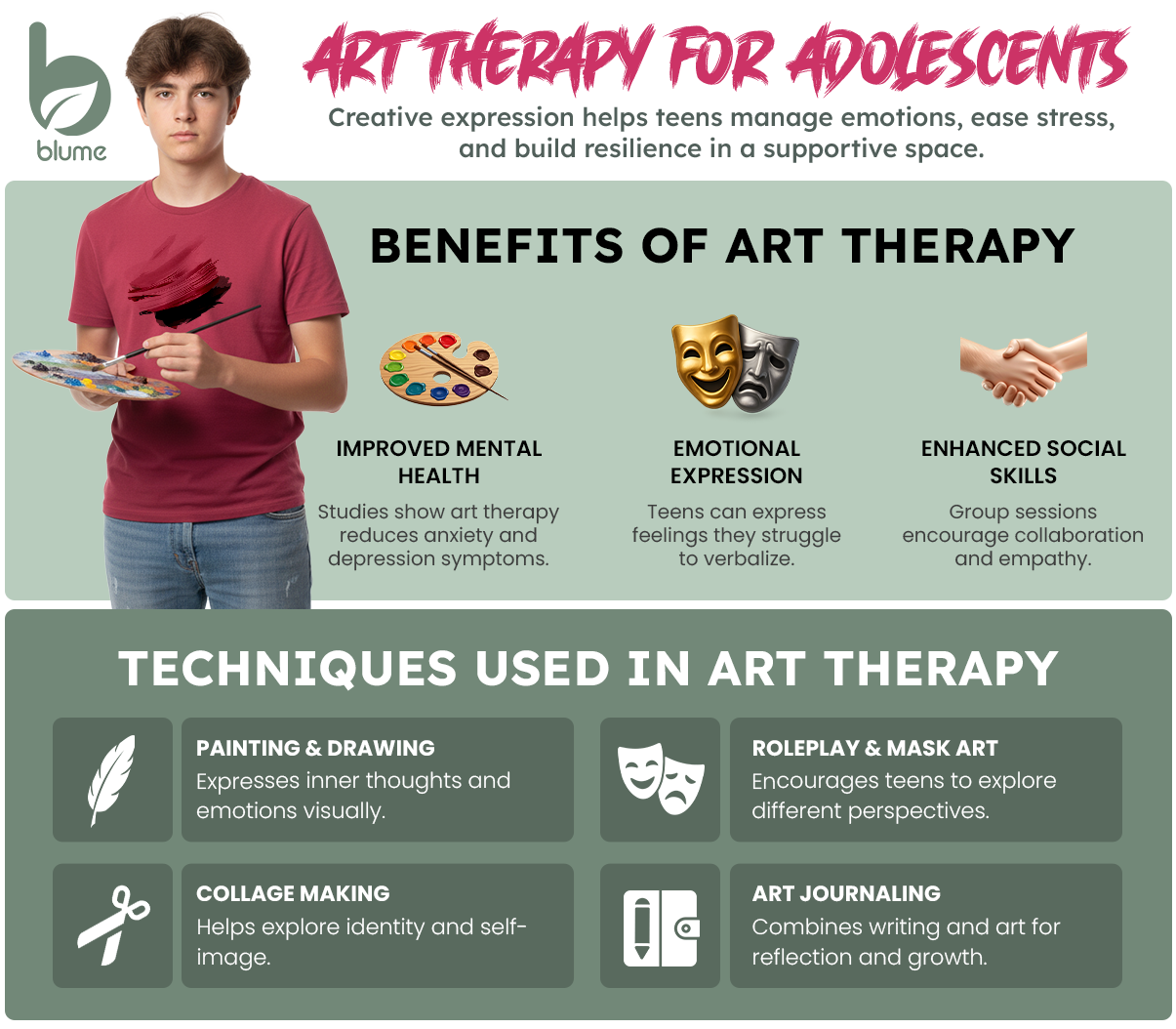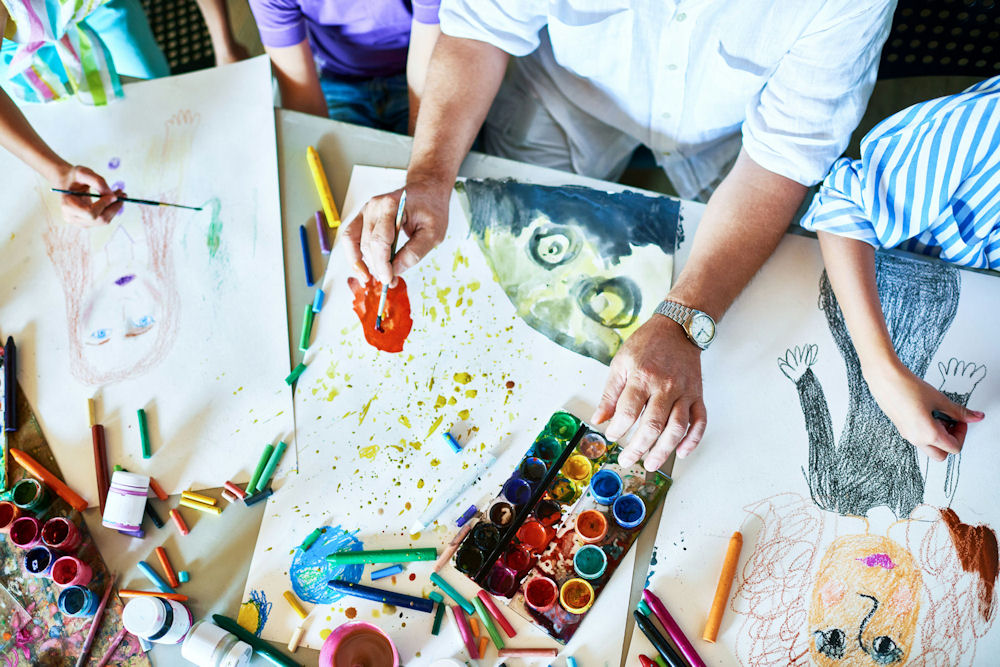
Art therapy for teens is a unique and effective approach to helping adolescents navigate the challenges of growing up. Through creative expression, art therapy provides a safe and non-judgmental space for teenagers to explore their thoughts, feelings, and experiences.
This powerful form of therapy has been shown to enhance self-awareness, promote emotional healing, and improve overall mental well-being in young individuals.
Our teen treatment programs can help you or a loved one learn coping mechanisms and overcome negative thinking patterns in a safe and supportive environment.

Art therapy is a form of psychotherapy that uses art as a means of expression and communication. It combines the benefits of traditional therapy with the creative process to help individuals explore their emotions, thoughts, and experiences.
The main goal of art therapy is to promote self-awareness, self-esteem, and personal growth. Through the use of various art materials, such as paint, clay, or collage, individuals can tap into their inner feelings and express them in a safe and non-verbal way.
Art therapists are trained professionals who use different techniques to engage clients in the art-making process. They provide a supportive and non-judgmental environment for clients to explore their emotions and gain insight into their struggles.
Art therapy has been used to address a wide range of mental health issues, including depression, anxiety, trauma, addiction, and stress-related disorders. It can be beneficial for people of all ages and backgrounds.
In addition to individual sessions, art therapy can also be used in group settings. Group therapy allows individuals to connect with others who may share similar experiences and provides a sense of community and support.
In art therapy, the therapist will guide the individual through different art techniques such as drawing, painting, sculpting, and collage-making. These art activities can serve as a means of self-expression and allow the individual to explore their inner world in a safe and supportive environment.
One of the main principles of art therapy is that the creative process itself is therapeutic. As individuals engage in making art, they can tap into their subconscious mind and access parts of themselves that may be hidden or repressed. This can lead to increased self-awareness, insight, and understanding of one’s emotions and behaviors.

The artwork created during an art therapy session becomes a tangible representation of the individual’s thoughts and feelings. This allows both the therapist and individual to reflect on the artwork together and gain further insight into underlying issues or patterns.
Art therapy also promotes relaxation and stress reduction by focusing on the present moment. The repetitive motions involved in creating art can have a calming effect on the mind and body, reducing anxiety and promoting mindfulness.
Additionally, art therapy can be used as a tool for processing traumatic experiences. By expressing these experiences through art, individuals may feel more in control of their emotions and find ways to cope with difficult memories.
One of the primary uses of art therapy is for the treatment of mental health disorders such as depression, teen anxiety, and post-traumatic stress disorder (PTSD). Creating art allows individuals to express themselves non-verbally, which can be beneficial for those who struggle to communicate their emotions verbally. Through the use of various art materials and techniques, individuals can gain insight into their emotions and experiences that they may not have been able to access through traditional talk therapy.
In addition to mental health disorders, art therapy has also been found to be effective in treating trauma-related issues. Many people who have experienced trauma may find it difficult to put their experiences into words or may feel overwhelmed by the intensity of their emotions. Engaging in creative processes during art therapy sessions can help individuals process and work through their traumatic experiences in a safe and supportive environment.
Art therapy has also shown promising results in treating substance abuse disorders. The creative process involved in making art can serve as a healthy outlet for individuals struggling with addiction. It allows them to channel their emotions into something productive and positive instead of turning to harmful substances.
Furthermore, art therapy has been utilized in the treatment of physical illnesses such as chronic pain and cancer. The act of creating art can serve as a distraction from physical discomfort and provide a sense of control over one’s body. Additionally, engaging in artistic activities has been linked to improved mood and reduced stress levels among patients dealing with physical illnesses.
There are several benefits of using art therapy for teens, including:
Q: What is art therapy for teens?
A: Art therapy for teens is a form of teen therapy that uses the creative process of making art to improve one’s physical, mental, and emotional well-being. It combines traditional psychotherapy techniques with various forms of visual art media.
Q: Who can benefit from art therapy for teens?
A: Art therapy can be beneficial for any teen who is struggling with mental health issues, emotional difficulties, or behavioral problems. It can also be helpful for those dealing with trauma, stress, self-esteem issues, and other challenges.
Q: How does art therapy for teens work?
A: Through the act of creating art, teens can express themselves in a non-verbal way. This allows them to explore their thoughts and feelings in a safe and therapeutic environment. The therapist then guides the teen through the creative process and helps them make connections between their artwork and their inner emotions.
Q: Is artistic ability required for art therapy?
A: No, artistic ability is not necessary for participating in art therapy. It is not about creating a masterpiece, but rather using the creative process as a means of self-expression and exploration.
Q: What types of materials are used in art therapy for teens?
A: The type of materials used may vary depending on the needs and preferences of the teen. Some common materials include paints, markers, clay, collage materials, and various drawing tools.
Q: How long does an art therapy session last?
A: Art therapy sessions typically last 45-60 minutes. However, the exact length may vary depending on individual needs and treatment plans.
Q: Is parental involvement required for teen art therapy?
A: Parental involvement may be recommended by the therapist depending on the goals of treatment. However, it ultimately depends on the individual needs of each teen.
Q: Can art therapy replace traditional talk therapy?
A: No, art therapy should not be seen as a replacement for traditional talk therapy. It can be used in conjunction with other forms of cognitive behavioral therapy (CBT) to enhance the healing process.
Q: How can I find an art therapist for my teen?
A: You can search for art therapists through professional organizations such as the American Art Therapy Association or consult with a mental health professional for recommendations.
Q: Is art therapy confidential?
A: Yes, just like traditional therapy, art therapy is confidential. The artwork created during sessions is only shared with the therapist and will not be shown to anyone else without the teen’s consent.
Blume Behavioral Health offers a comprehensive art therapy program specifically designed for teens. This innovative approach to therapy utilizes various forms of art, such as painting, drawing, sculpting, and collage-making, to help adolescents express their thoughts and emotions in a non-verbal manner.
Our licensed art therapists work closely with each teen to understand their unique struggles and provide personalized treatment plans. Our goal is to help teens develop healthy coping mechanisms and improve their overall well-being through meaningful self-expression.
Through art therapy sessions at Blume Behavioral Health, teens will not only learn how to manage their emotions but also gain a sense of accomplishment and empowerment as they create something that is uniquely theirs.
Our program also encourages social interaction among peers which can help improve communication skills and build healthy relationships. Contact us today for more information on our art therapy program.
Dr. Aneta Lotakov Prince is a board-certified psychiatrist with over 20 years of clinical experience treating adolescents and adults facing severe mental illness, co-occurring substance use disorders, and complex emotional and behavioral health challenges. Certified by the American Board of Psychiatry and Neurology, she holds an active DEA registration and California medical license. Dr. Prince’s patient-centered approach is rooted in compassion and driven by a dedication to improving quality of life and supporting long-term recovery. She remains deeply committed to empowering each individual she works with to build a life of purpose, connection, and resilience.